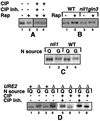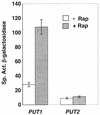Rapamycin treatment results in GATA factor-independent hyperphosphorylation of the proline utilization pathway activator in Saccharomyces cerevisiae
- PMID: 12796300
- PMCID: PMC161436
- DOI: 10.1128/EC.2.3.552-559.2003
Rapamycin treatment results in GATA factor-independent hyperphosphorylation of the proline utilization pathway activator in Saccharomyces cerevisiae
Abstract
Treatment of Saccharomyces cerevisiae cells with the immunosuppressive drug rapamycin results in a variety of cellular changes in response to perceived nutrient deprivation. Among other effects, rapamycin treatment results in the nuclear localization of the global nitrogen activators Gln3p and Nil1p/Gat1p, which leads to expression of nitrogen assimilation genes. The proline utilization (Put) pathway genes were shown to be among the genes induced by rapamycin. Having previously shown that the Put pathway activator Put3p is differentially phosphorylated in response to the quality of the nitrogen source, we examined the phosphorylation status of Put3p after rapamycin treatment. Treatment with rapamycin resulted in the hyperphosphorylation of Put3p, which was independent of Gln3p, Nil1p, and Ure2p. The relative contributions of global nitrogen (Gln3p and Nil1p) and pathway-specific (Put3p) activators to rapamycin-induced expression of the target gene PUT1 were also examined. We found that Nil1p and Put3p, but not Gln3p, play major roles in rapamycin-induced PUT1 expression. Our findings show that perceived nitrogen deprivation triggered by rapamycin treatment and steady-state growth in nitrogen-derepressing conditions are associated with hyperphosphorylation of Put3p and increased PUT1 expression. Rapamycin treatment and nitrogen derepression may share some, but not all, regulatory elements, since Gln3p and Nil1p do not participate identically in both processes and are not required for hyperphosphorylation. A complex relationship exists among the global and pathway-specific regulators, depending on the nature and quality of the nitrogen source.
Figures





 , Put3p dimers;
, Put3p dimers;  , proline;
, proline;  , positive GATA factors;
, positive GATA factors;  , negative GATA factors.
, negative GATA factors.Similar articles
-
Mutation of a phosphorylatable residue in Put3p affects the magnitude of rapamycin-induced PUT1 activation in a Gat1p-dependent manner.J Biol Chem. 2009 Sep 4;284(36):24115-22. doi: 10.1074/jbc.M109.030361. Epub 2009 Jul 1. J Biol Chem. 2009. PMID: 19574222 Free PMC article.
-
The regulator of the yeast proline utilization pathway is differentially phosphorylated in response to the quality of the nitrogen source.Mol Cell Biol. 2000 Feb;20(3):892-9. doi: 10.1128/MCB.20.3.892-899.2000. Mol Cell Biol. 2000. PMID: 10629046 Free PMC article.
-
Gln3p and Nil1p regulation of invertase activity and SUC2 expression in Saccharomyces cerevisiae.FEMS Yeast Res. 2005 Apr;5(6-7):605-9. doi: 10.1016/j.femsyr.2004.11.011. FEMS Yeast Res. 2005. PMID: 15780659
-
Nitrogen regulation in Saccharomyces cerevisiae.Gene. 2002 May 15;290(1-2):1-18. doi: 10.1016/s0378-1119(02)00558-9. Gene. 2002. PMID: 12062797 Review.
-
Transmitting the signal of excess nitrogen in Saccharomyces cerevisiae from the Tor proteins to the GATA factors: connecting the dots.FEMS Microbiol Rev. 2002 Aug;26(3):223-38. doi: 10.1111/j.1574-6976.2002.tb00612.x. FEMS Microbiol Rev. 2002. PMID: 12165425 Free PMC article. Review.
Cited by
-
The forkhead transcription factor Hcm1 promotes mitochondrial biogenesis and stress resistance in yeast.J Biol Chem. 2010 Nov 19;285(47):37092-101. doi: 10.1074/jbc.M110.174763. Epub 2010 Sep 16. J Biol Chem. 2010. PMID: 20847055 Free PMC article.
-
The ability of transcription factors to differentially regulate gene expression is a crucial component of the mechanism underlying inversion, a frequently observed genetic interaction pattern.PLoS Comput Biol. 2019 May 13;15(5):e1007061. doi: 10.1371/journal.pcbi.1007061. eCollection 2019 May. PLoS Comput Biol. 2019. PMID: 31083661 Free PMC article.
-
PP2A phosphatase activity is required for stress and Tor kinase regulation of yeast stress response factor Msn2p.Eukaryot Cell. 2004 Oct;3(5):1261-71. doi: 10.1128/EC.3.5.1261-1271.2004. Eukaryot Cell. 2004. PMID: 15470255 Free PMC article.
-
Mutation of a phosphorylatable residue in Put3p affects the magnitude of rapamycin-induced PUT1 activation in a Gat1p-dependent manner.J Biol Chem. 2009 Sep 4;284(36):24115-22. doi: 10.1074/jbc.M109.030361. Epub 2009 Jul 1. J Biol Chem. 2009. PMID: 19574222 Free PMC article.
-
The proline-dependent transcription factor Put3 regulates the expression of the riboflavin transporter MCH5 in Saccharomyces cerevisiae.Genetics. 2008 Dec;180(4):2007-17. doi: 10.1534/genetics.108.094458. Epub 2008 Oct 20. Genetics. 2008. PMID: 18940788 Free PMC article.
References
-
- Beck, T., and M. N. Hall. 1999. The TOR signalling pathway controls nuclear localization of nutrient-regulated transcription factors. Nature 402:689-692. - PubMed
-
- Bertram, P. G., J. H. Choi, J. Carvalho, W. Ai, C. Zeng, T.-F. Chan, and X. F. S. Zheng. 2000. Tripartite regulation of Gln3p by TOR, Ure2p and phosphatases. J. Biol. Chem. 275:35727-35733. - PubMed
Publication types
MeSH terms
Substances
Grants and funding
LinkOut - more resources
Full Text Sources
Molecular Biology Databases

